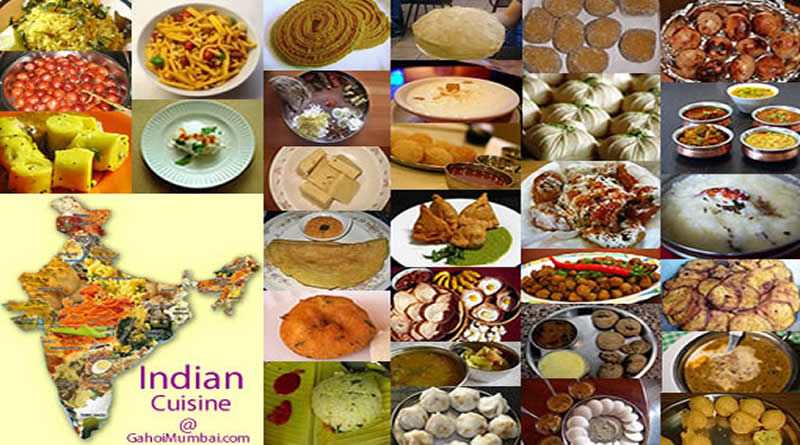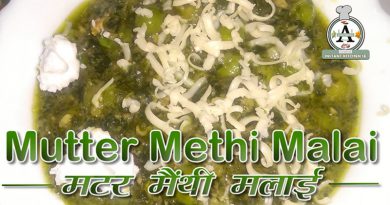About Indian Cuisine, History, Types And Recipes!
About Indian Cuisine, History, Types And Recipes!
Indian cuisine incorporates a wide-ranging variety of regional cuisines inherent from generation to generation. As per the diversity in soil type, climate and occupations, these cuisines are differ considerably from each other and use locally obtainable spices, herbs, vegetables and fruits.
Indian food is also deeply influenced by religious and cultural adoptions and traditions.
Indian Cuisines are as huge and extensive ranging due to its multi ethnic culture. The delicious and the mouthwatering dishes of India are striking by the subtle uses of spices and herbs.
Indian cuisines vary broadly from region to region. Varied regions adopt diverse cuisines. India is proud to serve the most varied cuisine in the entire world.
Every region has its own specialisms and varied way of cooking. The manner of cooking, flavor and their specialisms change with the landscapes. Most of the Indian cuisines are vegetarian but the Indians also love non-vegetarian delicacies cooked out of fish, lamb, goat, chicken and other meats. Food has always been important part of the Indian tradition and culture.
The evolution and development of wide-ranging Indian cuisines have been shaped by religion and traditional beliefs. The effect of vegetarianism can see in dietary trend in Indian society. There has also been Central Asian impact on North Indian cuisine from the years of Mughal rule. Indian cuisine has been and is still progressing, as a result of the nation’s cultural exchanges with other societies and worldwide migrants.
Historical happenings such as foreign invasions, trade relations and colonialism have also played a role in introducing some specific foods to the country. For example, the potato, an essential part of the Indian diet was brought to India by the Portuguese, who also introduced chilies and breadfruit. Indian cuisine has also shaped the history of international relations; the spice trade between India and Europe is often cited by historians as the main catalyst for Europe’s Age of Discovery. Spices were bought from India and traded around Europe and Asia. It has also influenced other cuisines across the world, specifically those from Southeast Asia, the British Isles, and the Caribbean.
History of Indian Cuisine:
Indian cuisine reveals a 5,000-year old history of several groups and cultures interacting with the subcontinent, leading to variety of flavours and regional cuisines found in modern-day India. Later, mughals, British and Portuguese’s invasion and influence added to the already varied Indian Cuisine.
In olden times, a standard diet in early India consisted of legumes, vegetables, fruit, grain, dairy products, honey, and sometimes eggs and meat. Over the time, segments of the population embraced vegetarianism. The introduction of Buddhism and Jainism in Indian’s life have affected this shift, as well as an reasonable climate permitting a variety of fruit, vegetables, and grains to be grown throughout the year. A food taxonomy system that categorized any item as Saatvic, Raajsic or Taamsic developed in time of Gita, Puran and Yoga tradition. During this period, consumption of beef became forbidden, due to cattle being considered sacred in Hinduism. Beef is generally not eaten by Hindus in India.
Common Ingredients of Indian Cuisine:
Essential foods of Indian cuisine include Pearl Millet (Bajra), Rice, Whole-wheat flour (Atta), and a range of lentils, particularly Masoor (most often Red Lentils), Toor (Pigeon Pea), Urad (Black Gram), and Moong (Mung Bean). Lentils may be used whole or split. Split lentils, or dal, are used extensively. Some pulses, such as channa (chickpea), Rajma or kidney beans, lobiya are very common, particularly in the northern regions. Channa and Mung are also processed into flour (Besan).
Numerous Indian dishes are cooked in vegetable oil, but peanut oil is common in northern and western India, mustard oil in eastern India, and coconut oil along the western coast, especially in Kerala. Gingelly (sesame) oil is common in the south since it imparts a peculiar fragrant nutty aroma.
In recent times, sunflower and soybean oils have become popular across India. Hydrogenated vegetable oil, known as Vanaspati ghee, is another well-known cooking medium. Butter-based ghee, or desi ghee, is used often, though less than in the past.
Many types of meat are used for India cooking, but chicken and mutton tend to be the most regularly consumed meats. Fish and beef consumption are predominant in some parts of India but they are not broadly consumed.
The utmost important and regularly used spices and flavourings in Indian cuisine are whole or powdered chilli pepper (mirch), black mustard seed (sarso), cardamom (elaichi), cumin (jeera), turmeric (haldi), asafoetida (hing), ginger (adrak), coriander (dhania), and garlic (lehsun).
One widespread spice mix is garam masala, a powder that typically includes five or more dried spices, especially cardamom, cinnamon (dalchini), and clove. Each culinary region has a unique garam masala blend—individual chefs may also have their own.
Some leaves normally used for flavouring include bay (tejpat), coriander, fenugreek, and mint leaves. The usage of curry leaves and roots for flavouring is typical of Gujarati and South Indian cuisine. Sweet dishes are often seasoned with cardamom, saffron, nutmeg, and rose petal essences.
Jammu & Kashmir:
Gustaba, Tabak Maz Dum Aloo, Haak or Karam ka Saag,
Uttrakhand:
Aloo ke Gutke, Kaapa, Jhangora (millets) ki , Kheer, Chainsoo
Uttar Pradesh:
Kabab, Biryanis, Bedmi Aloo Kachori, Banarasi Chaat,
Jharkhand:
Thekua, Pua, Pittha Marua-ka-roti,
Sikkim:
Momos, Thukpa, Gundruk Phagshapa and Seal Roti,
Manipur:
Iromba, Kabok, Chakkouba
Nagaland:
Momos, Rice Beer and , Cherry Wine,
Assam:
Masor Tenga, Pitha
Arunachal Paradesh:
Chinese Cuisine &, Apong (Local Beer),
Meghalaya:
Jadoh, Kyat (Local Beer), Bitchi,
Bihar:
Litti-Chokha, Sattu Paratha Khaja, Khubi Ka Lai, Anarasa, Tilkut
West Bengal:
Rosogulla, Mishti Doi, Bhapa Illish,
Tripura:
Chakhwi, Mwkhwi Muitru,
Mizoram:
Zu (a special tea)
Puducherry:
Kadugu yerra, Vendakkai, Patchaddy,
Andhra Pradesh:
Hyderabadi Biryani, Mirchi Salan, Ghongura Pickle Korikoora
Orissa:
Fish Orly, Khirmohan, Rasabali, Chhenapodapitha,
Tamil Nadu:
Appam, Dosai, Idli, Sambhar, Rasam, Chettinad Chicken Pongal
Kerala:
Puttu-Kadala, Kappa-Meen Kari Sadya Meal, Avial, Malabar Parotha Payasam, Irachi Stew, Karimean Kari
Karnataka:
Bisi Bele Bhaat, Kesari Bath, Mysore Pak, Dharwad Pedha, Chiroti
Goa:
Vindaloo, Xacuti, Bibinca, Prawn Balchao,
Maharashtra:
Shrikhand, Thalipeeth, Vada Pao, Modak, Pani Puri
Madhya Pradesh:
Lapsi, Bafla, Bhutte ki , Khees, Bhopali Kabab,
Gujarat:
Thepla, Dhokla Khandvi, Handvo, Panki
Chattisgarh:
Bafauri, Kusli Red Ant Chutney,
Rajasthan:
Dal-Bati-Churma Ker Sangari, Lal Maas, Gatte,
Delhi:
Chaat, Tandoori Chicken Paranthe, Chole Bhature,
Haryana:
Rabadi, Bajre ki Khichdi, Cholia, Chaach-Lassi, Kachri ki Sabzi,
Chandigarh:
Butter Chicken, Tandoori , Chicken, Mutton Pulao,
Punjab:
Dal Makhni, Makke di Roti-, Sarson da Saag, Chana Bhature,
Himachal Pradesh:
Sidu, Aktori, Dham Seppu Vadi, Badana, Babru,
If you need any help or have suggestions regarding Cuisine or Recipes related information, please leave your message at our Cuisine Help Centre.
All this information is free and only for informational purpose.




